Barbara Goette
| Barbara Goette | |
|---|---|
 | |
| Born |
26 July 1908 Germany |
| Died |
23 October 1997 (aged 89) Australia |
| Nationality | German, British and Australian |
| Education | mathematics, physics and philosophy |
| Alma mater |
Freiburg University Kiel |
| Occupation | Academic |
| Spouse(s) | J.P. Leidig |
| Children | 2 sons |
Barbara Goette (26 July 1908 – 23 October 1997) was an academic who lived in Germany and then Australia. She was the private secretary of Ludwig Roselius[1] from 1935 to 1943 who created the Böttcherstraße, Café HAG and financed Focke-Wulf.
Life and career
Barbara matriculated in Kassel in 1928 and began studying mathematics, physics and philosophy at Freiburg University and then Kiel where she took her state examinations in 1934/35. She met Dr Ludwig Roselius through the marriage of her brother to his youngest daughter and he suggested she work for the concern. Barbara became his companion, carer, confidante and collaborator.[2]
On 18/9/1936 during a meeting in Berlin, the RLM recommended reconstruction of Focke-Wulf with 50% going to the Reich (state) and 50% to a large electronics concern.[3]
A short time later the Roselius concern became majority shareholder with 46% and Lorenz (ITT) secured 27.8%. The aircraft company was reconstituted as Focke-Wulf Flugzeugbau GmbH. Barbara was instrumental in assisting with this and the Böttcherstrasse was reclassified as 'degenerate art'.[4]
After Dr Roselius died in May 1943 she lectured in English at the Humboldt Hochschule in Berlin until the premises were demolished during a bombing raid. In 1944 she started studying for her Ph.D. in philosophy at Kiel where she met Dr J.P. Leidig and they married in February 1945. Shortly after the war she acted as an interpreter for the military police in Gunzenhausen, Bavaria.[5]
In 1950 the family settled in Adelaide, Australia. Dr Leidig died in 1957 and Barbara was left with two sons. She never remarried and taught mathematics at Woodlands for 23 years. One year she had 4 out of the top 10 students in South Australia in her class and she received a congratulatory phone call from the Adelaide University Mathematics Department. She also worked as mathematics teacher until she was 81 at the Muirden College matriculation centre.[6]
A comprehensive posthumous interview by the Australian Our Time Channel 44 program (episode 188) on the life of Barbara Goette went Australia wide in 2015 and is available for viewing as referenced below.[7]
Writings and Publications
While still employed by the Roselius concern, Barbara wrote many articles on Dr Roselius including, 'Ludwig Roselius creates the Böttcherstraße' and 'Politics and Propaganda'. These were to be published by the Angelsachsen-Verlag in better times to come. An unpublished essay 'Ludwig the Philosopher' appears in the book that her son Ludwig wrote with Kevin Lower as researcher and Karen Collins as main editor. This book is a biography dealing mainly with Barbara's life in Germany during the Third Reich.[8] In 1944 Barbara risked her life by writing exactly the things that had infuriated Hitler in 1936 when he had attacked Dr Roselius and the Böttcherstrasse at the September Nuremberg Party Rally. This ten page essay was approved in September 1944 and was finally published by the Bremen Yearbook in 1951 and is included in the reference section. The controversial aspects were
- The Paula Becker-Modersohn museum which was the first museum in the world dedicated to a female artist and labelled 'degenerate art' by the Nazis.
- The 'Tree of Life' by Bernhard Hoetger depicting a Nordic sacrifice.
- Hoetger's architecture again 'degenerate'.
It was late 1935 when the SS newspaper 'Das Schwarze Korps' launched a vitriolic attack on Ludwig Roselius' Böttcherstrasse.[9]
Movie
In a film version, based on the biographical book Bombshell ( ISBN 9781625163462), Barbara Götte and her boss Ludwig Roselius hatch out a plot to blow up Hitler's Focke-Wulf Fw 200 while he was flying back to Germany from Smolensk in early 1943. The bomb fails to ignite and the Gestapo suspect that Roselius is involved. On the evening of 15/5/1943 in the Hotel Kaiserhof (Berlin) there is a violent confrontation between Hitler and Roselius - Barbara later returns from a ball to find Roselius dead.[10]
References
- ↑ Ludwig Roselius: Ein Nachruf von Barbara Götte, Bremisches Jahrbuch, 1951, www.brema.suub.uni-bremen.de/periodical/pageview/62875 viewed on 24/02/2012
- ↑ Pfliegensdörfer, D. Ludwig Roselius ... wie ihn keiner kennt. Werkstattberichte des Forschungsschwerpunkts Arbeit und Bildung Universität Bremen; 5, 1987.
- ↑ OMGUS document declassified per Executive Order 12958, Section 3.5 NND Project Number: NND 775058 By: NND Date: 1977
- ↑ Volker Bergmann, Willi Elmers, Manfred Fittgau, Michael Jung, Dieter Pfliegensdörfer, Michael Wolf unter Mitarbeit von Wolfgang Günther. Wellblech und Windkanal: Steintor, 1989 ISBN 3-926028-51-3
- ↑ Radio Bremen Online, 2011. Kaffee, Kunst, Kommerz - Das Leben des Ludwig Roselius. Accessed 25 May 2012. Pinguin Film Berlin, 13 January 2011. <www.radiobremen.de/vide021856-popup.html>
- ↑ The West Australian News: "Returning to Adelaide." (Perth, WA: 1879-1954), viewed 30 Sept. 2012. http://nla.gov.au/nla.news-article 47842318
- ↑ https://www.youtube.com/watch?v=Fv82pXnNmrM&feature=youtu.be&t=11m43s
- ↑ Leidig, Ludwig. Bombshell. sbpra, 2013, ISBN 978-1-62516-346-2
- ↑ Das Schwarze Korps; 24/10/1935; pages 11,34
- ↑ Ludwig Leidig LinkedIn - screenplay based on the book Bombshell ISBN 9781625163462 - registered with WGA in LA; registration no. 1851846; effective date 7/23/2016; registrant Ludwig Leidig